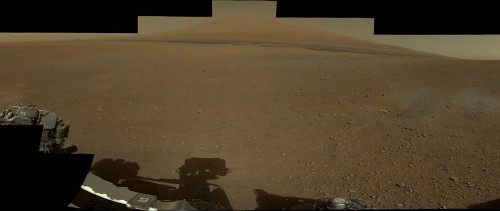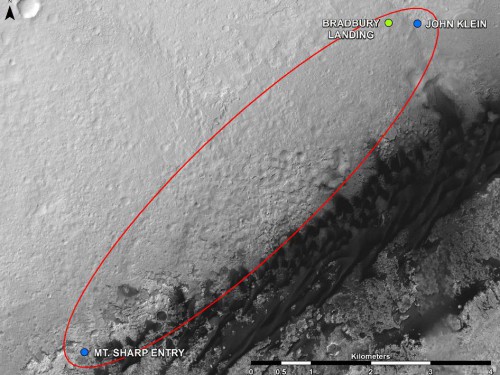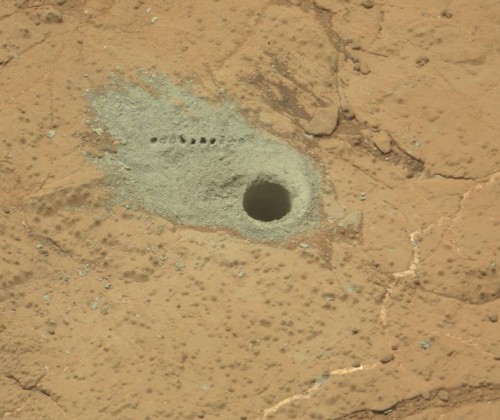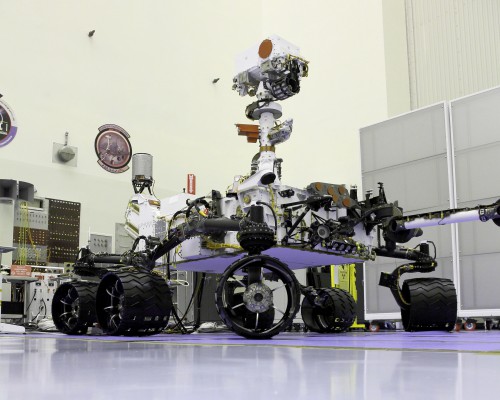
Curiosity is approaching the biggest turning point to date in its planned two-year mission of exploration on the Red Planet. This is according to NASA officials at the Jet Propulsion Laboratory (JPL), located in Pasadena, Calif. Mission managers spoke with journalists on Wednesday, June 5 and detailed the Mars Science Laboratory (MSL) rover’s most recent activities on Mars.
“After we completed the activities at the first drill target, the second target, Cumberland, which is nearby was chosen to increase the ratio of concretion material as well as to decrease the ratio of any residual material … ,” said Joe Melko, MSL sampling activity lead. “The proximity between the first drilling targets, John Klein, is about nine feet away from Cumberland.”
To move between the two points, Curiosity backed up, pivoted, and then pulled forward to Cumberland.
The one-ton rover is currently in the process of concluding research in its present location, which encompasses an area slightly smaller than a football field. The rover has been poking around this section of Gale Crater (which the rover landed in back in August of last year) for the past six months. Scientists have been in no hurry to move on, as they are motivated by the scientific opportunities that abound in the region.

Scientists currently have no further plans to conduct any other rock drillings or soil collections at Glenelg. Curiosity had to travel about a third of a mile (500 meters) from where it landed. To reach Mount Sharp the rover will have to travel for months before reaching its destination. There is not a specific time that planners are expecting the rover to reach the peak at the center of Gale Crater. This is due to the simple fact that mission planners have no idea what they might find along the way.
“We don’t know when we’ll get to Mount Sharp,” said Jim Erickson, MSL project manager. “This truly is a mission of exploration, so just because our end goal is Mount Sharp doesn’t mean we’re not going to investigate interesting features along the way.”
As soon as scientists wrap up their investigations, it will start the 5-mile (8-kilometer) trek to the base of Mount Sharp (the official name of this natural feature is Aoelis Mons). The science team is not quite finished with the Glenelg area just yet, however.
“Before we start our trip to Mount Sharp, the science team wants to follow up three things that we saw on our way here,” said Joy Crisp, MSL’s deputy project scientist. “Each of these will take a few days; we want to complete a systematic set of ban neutron spectrometer measurements and we want to revisit Point Lake and Shaler.”

The MSL team has got several things on its “to-do” list before setting Curiosity on her extended road trip.
“One of our goals is to acquire a series of passive and active measurements along a rover drive that crosses the boundary between the sheet-bed and the Gillespie rock units. The sheet-bed unit is the stratigraphically lowest one in Yellowknife Bay; it’s the fine-grain sedimentary rock that we have drilled,” Crisp said. “In the analysis of the first drill hole we saw a lot of water released when we heated the sample in SAM instrument oven, and also CheMin detected an abundant clay mineral which contained water. With the DAN instrument we’re interested in finding out if there is a systematic difference in hydrogen abundance as the rover goes from this clay-rich sheet-bed unit to the coarser-grain Gillespie unit.”
While Curiosity might be firmly planted on the dusty Martian terrain, eyes in the sky serve to direct where the scientists will direct her. In imagery taken by the fleet of orbiters, layered levels of rock serve as a book of sorts that Curiosity can “study” to determine the geological history of Mars. This “book” will allow a better understanding of how Mars’ environment changed over the epochs.
Last month Curiosity drilled its second rock target to gather sample materials. It then deposited the samples into the rover’s suite of scientific instruments. Curiosity’s team is getting more efficient at accomplishing this procedure. It only took them a week, just a quarter of the time to accomplish the process compared to the first drill.
Despite this, it might appear as if the team guiding the $1 billion mission might be dawdling. However, the rover has already completed its primary science objective. Once the findings from the first drill at the “John Klein” site were finished, it was determined that Mars was once capable of supporting microbial life. Scientists used a basic formula to determine this: the essential ingredients needed for life, energy to fuel those life forms, and water that neither too briny nor acidic.
To validate these findings the team moved over to the aforementioned Cumberland. Curiosity can still be on the move while studying samples it collects.
Curiosity is a nuclear-powered rover that was launched in November 2011 from Cape Canaveral Air Force Station in Florida on a two-year mission to determine if Mars was ever capable of supporting microbial life. The rover has 10 scientific instruments and touched down on the Red Planet in August 2012.

Want to keep up-to-date with all things space? Be sure to “Like” AmericaSpace on Facebook and follow us on Twitter: @AmericaSpace



